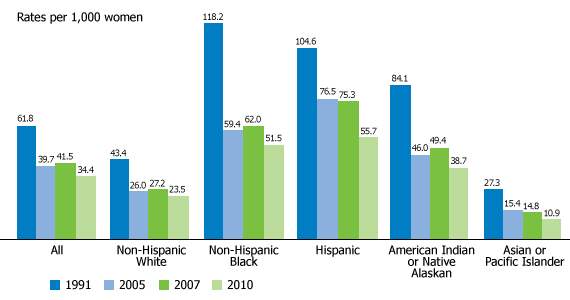
U.S. Teen Birth Rate Hits New Low, Still Higher Than Europe's
Date
April 26, 2012
Author
(April 2012) The U.S. teen birth rate declined 9 percent between 2009 and 2010 to reach a historic low of 34.4 births per 1,000 women ages 15 to 19, reported the National Center for Health Statistics (NCHS).1 But compared with other industrialized countries, U.S. teen birth rates continue to be among the highest. For example, the U.S. teen birth rate is more than twice as high as in Spain (12.2) and Ireland (16.3), and five times as high as in Italy.2
The 2010 teen birth rate was 44 percent below the recent peak in 1991, and 64 percent lower than the all-time high level of 96.3 recorded during the baby-boom year of 1957, according to the NCHS report. Fewer babies were born to teenagers in 2010 than in any year since the mid-1940s.
Teen birth rates by age and race and Hispanic origin were lower in 2010 than ever reported in the United States, but large disparities remain (see figure). Rates in 2010 ranged from 10.9 per 1,000 Asian or Pacific Islander teenage women to 55.7 for Hispanics.
Birth Rates for U.S. Women Ages 15 to 19, by Race and Ethnicity

Note: Data for 2010 are preliminary.
Source: Brady E. Hamilton and Stephanie J. Ventura, “Birth Rates for U.S. Teenagers Reach Historic Lows for All Age and Ethnic Groups,” NCHS Data Brief 89 (2012). U.S. Census Bureau.
If the teen birth rates observed in 1991 had not declined through 2010 as they did, there would have been an estimated 3.4 million additional births to teens during that period, according to the NCHS analysis. Teen birth rates by state vary significantly, reflecting in part differences in the racial and ethnic composition of state populations. The birth rate for teenagers ranged from 15.7 in New Hampshire to 55.0 in Mississippi in 2010. Rates tended to be highest in the South and Southwest and lowest in the Northeast and Upper Midwest, a long-standing pattern.
A number of studies credit the impact of strong teen pregnancy prevention programs with birth rate declines.3 Other analysts find that prevention programs have little if any impact; they argue that teen childbearing reflects the perceived lack of economic opportunity among low-income teens in states with high levels of income inequality.4
Other trends also may have contributed to the recent declines: New data from the National Survey of Family Growth, conducted by NCHS, show increased use of contraception at first initiation of sex and use of dual methods of contraception (that is, condoms and hormonal methods) among sexually active teens.5
References
- Brady E. Hamilton and Stephanie J. Ventura, “Birth Rates for U.S. Teenagers Reach Historic Lows for All Age and Ethnic Groups,” NCHS Data Brief 89 (2012).
- United Nations Statistics Division, Demographic Yearbook 2009-2010, accessed April 12, 2012.
- Douglas Kirby, Emerging Answers 2007: New Research Findings on Programs to Reduce Teen Pregnancy (Washington, DC: The National Campaign to Prevent Teen and Unplanned Pregnancy, 2007).
- Melissa Schettini Kearney and Phillip B. Levine, “Why is the Teen Birth Rate in the United States so High and Why Does it Matter?” National Bureau of Economic Research Working Paper No. 17965 (March 2012), accessed April 12, 2012.
- Gladys Martinez, Casey E. Copen, and Joyce C. Abma, “Teenagers in the United States: Sexual Activity, Contraceptive Use, and Childbearing, 2006–2010 National Survey of Family Growth,” Vital Health Statistics 23, no. 31 (2012).
